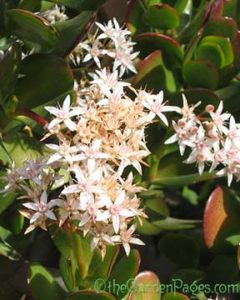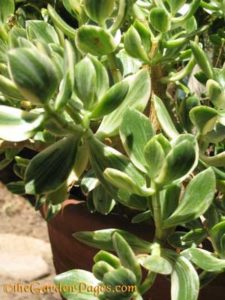
Crassula ovata or Jade plants are shrubby succulent plants that make excellent choices for dry landscapes and container gardens.
Xeriscaping with drought tolerant cactus and succulent plants has become popular in dry areas or places where water conservation is a concern.
Jade plants have thick, deep green leaves sometimes tinged with red on the edges. The leaf shape, like the name ovata implies, are oval from 1 – 2 inches long.
Crassula ovata develop thick, fat trunks that have an aged look and will eventually grow up to 8 feet tall.
In late winter, jade plants get 3 inch clusters of light pink to pale salmon flowers with five petals. These perennial succulent plants are drought tolerant and only need water once a month or so.
Some varieties are variegated, meaning they have green and white stripes on their leaves. Other Jade plants have a pink or red tint around the edges of their leaves. These shrubs have the same general requirements as regular crassula ovata.
Indoors, jade plants make good houseplants in containers. They prefer bright, indirect light and can take a few hours of direct sunlight but they are also adapted to low light.

For container gardening try growing jades in a pot, they grow much slower, stay small and can even be used for bonsai.
Crassula ovata is sometimes confused with Crassula argentia, which has a similar growth habit, but has silvery gray leaves.
Crassula are usually not bothered by insects or disease. The biggest problem crassulas face may come from over watering. This will result in a soggy brown, rotting trunk.
In the garden, jade plants will grow in shade to full sun. In hottest areas, crassula do better when they don’t have an entire day of full sun. Crassula ovata are hardy to 41 degrees (5 degrees centigrade).
A light frost will show up at brown dots on leaves. Overhead protection is usually enough to protect succulents during a light frost. The brown spots from frost damage will no go away, but new growth will be green.
Heavy frost, or a deep freeze will turn leaves brown and shriveled. Frozen leaves will fall off, or you can brush them off with your hands. If the plant branch or trunk is not damaged, new sprouts will form in a few weeks.
Green jade plants are able to live off rainfall alone in many areas. In my southern California garden, crassula are happily growing in both full sun and shade, in heavy alkaline, clay soil.
How To root succulents like jade plant or gollum jade:
Start with a 5 or 6 inch cutting. Bury about half of the stalk in soil. This will give you deep roots and helps the plant withstand drought better. Keep the soil moist (like a squeezed sponge).
After a month, cut back to monthly watering. The leaves will probably shrivel a bit as the plant forms roots: it is living off the stored energy in its leaves. This is normal. You may also lose a few leaves, which is also normal. The plant will start growing again and may even flower in a year. Crassula plants are versatile and easy to grow and care for. Their winter bloom make jade plants a great addition to any garden or home.